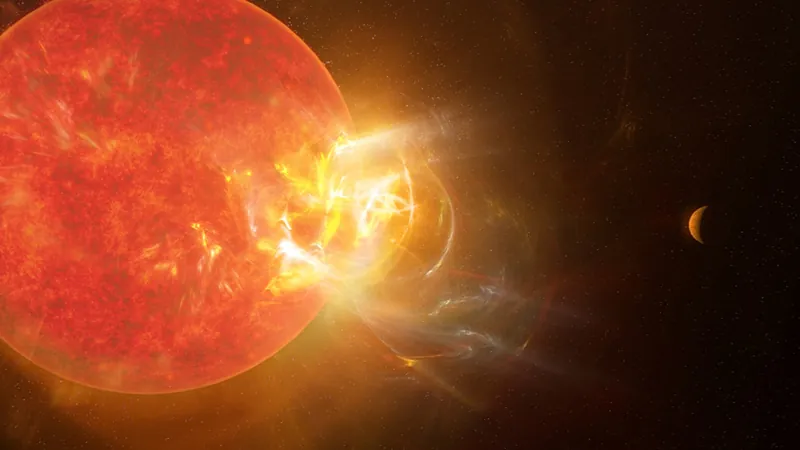
ALMA Reveals Stunning New Insights into Proxima Centauri's Flare Activity
2025-03-29
Author: Arjun
In a groundbreaking study, astronomers have unveiled a new perspective on Proxima Centauri, our closest stellar neighbor situated just over four light-years away. This active M dwarf star, known for its energetic flares, has long captivated scientists, but recent observations from the Atacama Large Millimeter/submillimeter Array (ALMA) have opened the door to understanding its dynamic behaviors in radio and millimeter wavelengths.
Proxima Centauri already has a reputation for its significant flare activity observable in visible light. These powerful outbursts resemble those of our Sun but are much more frequent and intense. As researchers delve deeper into the nature of these flares, they find that they can have severe implications for the star's potentially habitable planets. The flares release bursts of stellar energetic particles and electromagnetic radiation across various wavelengths, potentially affecting the atmospheres of nearby planets situated within the star's habitable zone.
A research team led by astronomers Kiana Burton from the University of Colorado and Meredith MacGregor from Johns Hopkins University has taken a closer look at Proxima Centauri's millimeter-wavelength flare activity. Their observations indicate that the star's unique size and magnetic properties contribute to its high level of activity. Unlike the Sun, which has both convective and non-convective layers, Proxima Centauri appears to operate entirely convectively, resulting in frequent magnetic reconnections that produce energetic flares.
"Unlike our Sun, which enriches Earth’s atmosphere with stunning auroras, Proxima Centauri’s flares are more intense and could be detrimental to its rocky planets," MacGregor explained. "The potential for atmospheric erosion or chemical modification from these energetic outbursts raises significant questions about the habitability of these worlds."
This research marks a historic multi-wavelength study that combines extensive ALMA observations, totaling about 50 hours, to document an impressive 463 flares. Each event produced energies between 10^24 to 10^27 ergs and lasted anywhere from three to sixteen seconds. The detailed analysis of these flares and their properties offers unprecedented insight into the physical mechanisms at play.
What's particularly groundbreaking is the discovery of a distinct frequency distribution of flare events based on their energy levels. Smaller flares occur more frequently, while larger, higher-energy events are rarer. The findings suggest that Proxima Centauri experiences a greater number of these energetic flares than previously understood. The asymmetrical nature of these flares indicates that their decay phase is prolonged, contributing to the overall energy dynamics of the star.
ALMA's capability to observe in millimeter wavelengths allows astronomers to gather vital information that would be lost if only optical measurements were taken. MacGregor noted, “ALMA provides a critical lens through which we can observe these phenomena more intricately,” emphasizing the importance of this facility in enhancing our understanding of stellar dynamics.
With the potential discovery of more habitable exoplanets around nearby stars, understanding the impact of stellar flares on planetary atmospheres is crucial. As astronomers continue their exploration of Proxima Centauri, they are not only shedding light on the nature of this intriguing star, but also setting the stage for future missions that may focus on the habitability of exoplanets across the cosmos.
Stay tuned for more exciting discoveries as our understanding of the universe evolves!


 Brasil (PT)
Brasil (PT)
 Canada (EN)
Canada (EN)
 Chile (ES)
Chile (ES)
 Česko (CS)
Česko (CS)
 대한민국 (KO)
대한민국 (KO)
 España (ES)
España (ES)
 France (FR)
France (FR)
 Hong Kong (EN)
Hong Kong (EN)
 Italia (IT)
Italia (IT)
 日本 (JA)
日本 (JA)
 Magyarország (HU)
Magyarország (HU)
 Norge (NO)
Norge (NO)
 Polska (PL)
Polska (PL)
 Schweiz (DE)
Schweiz (DE)
 Singapore (EN)
Singapore (EN)
 Sverige (SV)
Sverige (SV)
 Suomi (FI)
Suomi (FI)
 Türkiye (TR)
Türkiye (TR)
 الإمارات العربية المتحدة (AR)
الإمارات العربية المتحدة (AR)